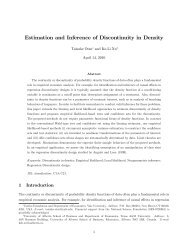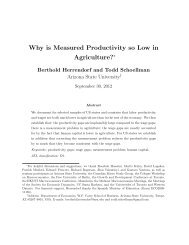10 Appendix 2: The Proof of Lemma 8(1) Let {E n } n ⊂ S be a sequence of Ky Fan sets such that h w ∗ ×w ∗(En ,E 0 ) → 0. Wemust show that E 0 ∈ S. Becauseh w ∗(D(E n ), D(E 0 )) → 0<strong>and</strong> because each D(E n )=R(E n ) is convex, we have that D(E 0 ) ∈ P w ∗ fc(X) <strong>and</strong>D(E 0 )=R(E 0 ). Thus, E 0 satisfies (Z1). Also, note that E 0 satisfies (Z2). Theproof will be complete if we can show that for all x ∈ R(E),{y ∈ D(E) :(y, x) /∈ E}is convex <strong>and</strong> possibly empty (i.e., that E 0 satisfies (Z3)). Suppose not. Then forsome y 1 , y 2 ,<strong>and</strong>x 0 in R(E 0 ),wehavey i ∈ © y ∈ D(E 0 ):(y,x 0 ) /∈ E 0ª , i =1, 2, (*)but for some λ 0 ∈ (0, 1), y 0 = λ 0 y 1 +(1− λ 0 )y 2 ∈ D(E 0 ) but(y 0 ,x 0 ) ∈ E 0 . (**)Because D(·) is continuous (<strong>and</strong> in particular, lower semicontinuous) there exist sequences,{y 1n } n <strong>and</strong> {y 2n } n , such that y in ∈ D(E n ) for all n, i =1, 2, <strong>and</strong>y 1n → y1 ,w ∗y 2n → y2 .w ∗Therefore,y 0n = λ 0 y 1n +(1− λ 0 )y 2n →w ∗ y0 ∈ D(E n )We have (y 1 ,x 0 ) /∈ E 0 , (y 2 ,x 0 ) /∈ E 0 , but (y 0 ,x 0 ) ∈ E 0 .Becausewe have for all n sufficiently large,(y in ,x 0 ) →w ∗ ×w ∗ (yi ,x 0 ) /∈ E 0 , i =1, 2,<strong>and</strong>h w ∗ ×w ∗(En ,E 0 ) → 0,(y in ,x 0 ) /∈ E n , i =1, 2.Because E n ∈ S for all n, wehaveforalln sufficiently large,(y 0n ,x 0 )=(λ 0 y 1n +(1− λ 0 )y 2n| {z }y 0n ,x 0 ) /∈ E n .Thus,(y 0n ,x 0 ) ∈ [D(E n ) × X] ∩ [(X × X)\E n ] for all n.50
Because E n → E 0 , we have by Proposition 3.2.2 in Klien <strong>and</strong> Thompson (1984)hw ∗ ×w ∗that(X × X)\E 0 = Li w ∗ ×w ∗{(X × X)\En }. (82)Given (82), we have, therefore, that£D(E 0 ) × X ¤ ∩ £ (X × X)\E 0¤ = £ D(E 0 ) × X ¤ ∩ Li w ∗ ×w ∗{(X × X)\En }. (83)But now we have a contradiction. We haveThus,(y 0n ,x 0 ) −→w ∗ ×w ∗ (y0 ,x 0 ) ∈ £ D(E 0 ) × X ¤ ∩ Li w ∗ ×w ∗{(X × X)\En }.(y 0 ,x 0 ) ∈ £ D(E 0 ) × X ¤ ∩ £ (X × X)\E 0¤ .But by assumption,(y 0 ,x 0 ) ∈ £ D(E 0 ) × X ¤ ∩ £ E 0¤ ,a contradiction.(2) It is easy to see that D(K(z)) = R(K(z)) = Φ(z). Thus (Z1) holds. Letz ∈ Z be any parameter vector. We must show that K(z) ∈ S. RecallthatK(z) :={(y, x) ∈ Φ(z) × Φ(z) :ϕ(z,(y, x)) ≤ 0},<strong>and</strong> note that for all y ∈ Φ(z), ϕ(z, (y, y))=0. Thus, (Z2) holds.Toseethat(Z3)holdsobservethatbecauseϕ(z, (·,x)) is quasiconcave, y ∈ Φ(z)such that(y, x) /∈ K(z)is given by the set,{y ∈ Φ(z) :ϕ(z,(y, x)) > 0},<strong>and</strong> this set is convex (or empty).11 Appendix 3: The Proof of Lemma 11Because S is an h w ∗ ×w∗-compact metric space <strong>and</strong> hence a Baire space <strong>and</strong> becausen(·) is a minimal USCO, there is an h w ∗ ×w∗-dense subset, D, ofS such n(E) is asingleton for all E ∈ D (see Anguelov <strong>and</strong> Kalenda, 2009, Lemma 7). Moreover, forany E e ∈ S, D eE := D ∩ S eE is dense in S eE .Suppose n(·) ∈ [N(·)] but that for some E e ∈ S, n eE (·) is not a minimal USCO ofNE e (·) on S eE . Then, there is a minimal USCO m(·) of n eE (·) (i.e., m(·) ∈ [n (·)]) sucheEthat for some E 0 ∈ SE e , m(E0 ) is a proper subset of nE e (E0 ). By Lemma 11, becausem(·) ∈ [n eE (·)], wehaveforanyE 0 ∈ S eE , m(E 0 ) ∈ M n eE (E 0 )(S eE ),implyingthatforall ε 0 > 0 there exists δ 0 > 0 such that for allE ∈ B hw ∗ ×w ∗ (δ 0 ,E 0 ) ∩ SE e , ⎫⎬(84)n eE (E) ∩ B w ∗(ε 0 ,m(E 0 ⎭)) 6= ∅.51
- Page 5: cally approximated by continuous fu
- Page 12 and 13: the set x 0 x 1 ∈ C w ∗ f(X) is
- Page 14 and 15: defined on some probability space,
- Page 16 and 17: contains at most one arc (i.e., ¯
- Page 18 and 19: into the collection of Ky Fan sets
- Page 20 and 21: 3.1 Best Response MappingsLetting p
- Page 22 and 23: 4.1 Nikaido-Isoda FunctionsWith eac
- Page 24 and 25: Because Φ(z) × Φ(z) is w ∗ ×
- Page 26 and 27: where for all n, C n ∈ S E n,then
- Page 28 and 29: Definition 4 (The 3M Property - The
- Page 30 and 31: Given (48) and the fact that for n
- Page 32 and 33: We note that if m(z) ∈ P w ∗ f(
- Page 34 and 35: 6.3 AK Convergence of Minimal Nash
- Page 36 and 37: and Gr ρZ ×w ∗f ∗ (·) is the
- Page 38 and 39: In particular, for all n ≥ N 0 an
- Page 40 and 41: the cutting defined by the cut poin
- Page 42 and 43: According to our main result, under
- Page 44 and 45: By our main approximation result, f
- Page 46 and 47: 9 Appendix 1: USCO FundamentalsIn t
- Page 48 and 49: 9.3 Equi-QuasicontinuityIn order to
- Page 50 and 51: 9.5 Dense SelectionsFor each F ∈
- Page 54 and 55: Noting that if E ∈ D eE ,thenn eE
- Page 56 and 57: 12 Appendix 4: The Proof That All K
- Page 58 and 59: Letting E 1 =[E 1 \(X × U 2 )] ∪
- Page 60 and 61: [10] Bryant, V. W. (1970) “The Co
- Page 62: [42] Ward, L. E., Jr. (1958) “A F






